
Today’s cocktail recipe is brought to you by Dan (Rachel’s husband). Photography by Rachel.
Cherry season is at it’s peak in southeastern Pennsylvania and I’ve been dying to try an idea that I’ve been nursing for a while. Last summer I made a batch of brandied cherries from a recipe that called for star anise, the sweet, licorice-flavored spice grown in China and used widely in many staple dishes of Asian and Indian cuisine. From my brandied cherry experiment, I discovered that star anise pairs very well with fresh cherries, especially the bright red sour Morello and Montmorency varieties. Given the reciprocal nature of these flavors, it gave me an opportunity to explore an anise-flavored spirit that has oft been shrouded in mystery, one of which I wanted to gather some more concrete facts about: absinthe!

As an art school graduate, I was steeped in the legacy of absinthe, especially as it related to the late 19th and early 20th C bohemian artist culture in Paris. Derived from anise, wormwood, and sweet fennel mixed with a neutral distilled alcohol, it has a strong licorice flavor and was said to arouse the senses, cause hallucinations, and the like. Artists, in particular, were drawn to it in search of new ways to stimulate creativity and create unusual experiences from which they could draw upon to produce art with greater depth. The “little green fairy” as it was called due to the drink’s pearly green appearance, found it’s way into the folklore of the era, gaining popularity both in Europe and overseas in America as well until the growing temperance movement put an end to it. By 1915 it was effectively banned across much of Europe and America. Absinthe’s alleged hallucinogenic effects were later conclusively proven false, and it is today believed that the reports of such experiences were more likely due to the combination of the spirit’s high alcohol content (usually in the neighborhood of 60-75%), improper distillation methods, and toxic coloring additives used at the time. Given the emerging science proving original-recipe absinthe to be no more harmful than most other spirits, the drink was eventually made legal again, including across the USA in 2007, a mere 8 years before this writing.
The allure of the drink, apart from it’s fabled psychoactive properties, lies in the ritual surrounding it’s consumption. Traditionally, absinthe is prepared by putting one “dose,” usually an ounce, in the bottom of a glass. Some absinthe glasses have a measuring line or bubble just above the stem to mark the proper dose. A sugar cube is then placed on a special perforated spoon that rests across the top of the glass. Ice water is slowly dripped onto the cube and the sugar-water mixture drips evenly down into the spirit, causing the absinthe to “louche,” or turn a milky pale green as the sugar reacts with the botanicals. The water also helps to dilute the strong alcohol content, making the absinthe more pleasant to drink and opening up the flavor, much for the same reason that water is often added to bourbon or Scotch whiskey.


For this recipe I wanted to explore the flavor combination of the fresh cherries and anise, while also giving a nod to the traditional preparation of absinthe with sugar. Using powdered sugar with the absinthe and cherries tasted great, but I needed a vehicle to create the body of the cocktail. Absinthe is too strong by itself to constitute more than about a quarter of a drink mixture before it begins to overpower everything else. Indeed, some cocktails call for only a rinse of absinthe in the glass to add the aromatic qualities without affecting the flavor. That said, I landed on white rum. Being distilled from sugar cane and imparting that sugary sweetness into the mixture, it made perfect sense.
The absinthe I chose was Vieux Carré, made right in my backyard by Philadelphia Distilling. I also used Bacardi white rum and Peychaud’s Aromatic Cocktail Bitters (the best bitters for absinthe, in my opinion). One final note: I can’t stress enough how important it is to make this cocktail with sour cherries. The sourness of the fruit mixed with the sweetness of both the rum and absinthe are delicious and balance each other out perfectly. So go ahead, raise some eyebrows and bring home a bottle of absinthe this weekend. Regale your friends with stories of wild bohemian art colonies, of mad hallucinations, and bursts of creativity induced by the “little green fairy.” Just remember to keep her secret to yourself!

Impress your friends and raise some eyebrows when you serve this decadent, sweet, and seasonal cocktail. With each sip, the "little green fairy" will share some of her mysteries with you!
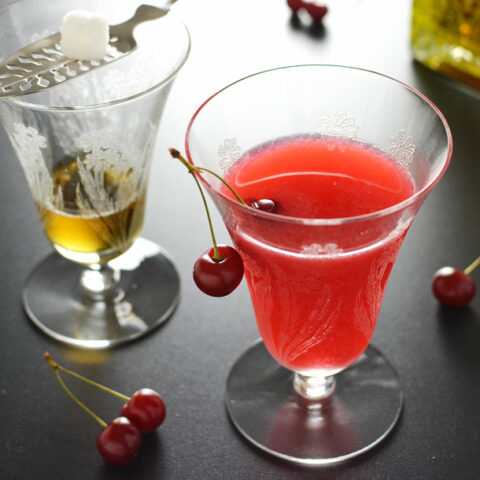
Sour Cherry Absinthe Cocktail
Ingredients
Instructions



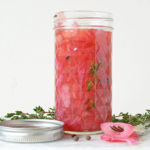
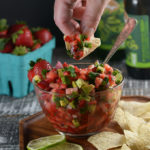
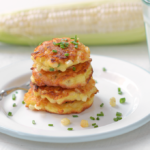
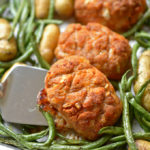

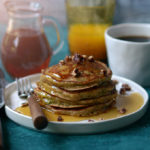


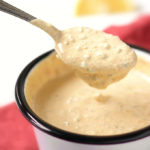
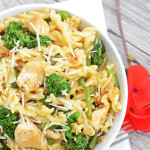
This sounds great, can’t wait to make for our party this weekend! YUMMed for later!
Thanks Cindy!
I’m fairly new to Absinthe… but I’m loving it! I can totally imagine these flavors together, and I think that top one has my name on it! Forwarding this to my girlfriend who is our neighborhood cocktail maker. Cheers!
Thanks Kim, and thanks for forwarding! Yeah, absinthe is definitely an acquired taste, but it does grow on you over time.
Absinthe cocktail! Love the combination of cherry and absinthe
Thanks Amanda!
This looks like a great cocktail! Wonderful photos!
Thanks Olivia!
Great dish, loved ur space.
Thanks Deepa!
I NEVER knew all this about Absinthe! I must confess that I have always wanted to try it but been afraid of the so called hallucinations that you experience (which now I know is all a lie!! :D) There was something always so magical about it though… It’s probably the pale glowing green.
Definitely need to check out our local places for some good absinthe! Thank you so much for this fantastic post! I learnt so much!
Dini – your comment totally made my day! Glad to see that some myths were dispelled and I hope you go out and enjoy some absinthe soon. Thanks for reading!
Looks so delicious! I need a patio and this drink right now!
Ha, thanks Byron. I would start with the drink. Much lower cost of entry… 😉
Pinned!!! I would love it if you would link this up to my weekly cocktail link up – Tipsy Tuesday at Grey is the New Black!
Thanks Pam, and thanks for the invitation!
Oh, I love a good cocktail! This looks amazing! Pinning this for later. 😀
Thanks Marissa, and thanks for pinning!
What beautiful pictures. It makes me want to dive right in. Lovely looking cocktail!
Thanks Kelly!
I love cocktails and I love sour things so this is right up my street! Looking forward to trying it.
Thanks Mel!
Great cocktail! Love the glasses too. So cute!
Thanks Olivia!
I love finding new and different cocktail recipes! I’m terrible at inventing my own so I’m definitely adding this to the list!
Meaghan- I’m clueless when it comes to cocktails. That’s where Dan, my mixologist, comes in! If you’re looking for more cocktail inspiration, he’ll be contributing from time-to-time!
I have to admit, I’ve never tried absinthe. I’ve seen it alllllll over the place, but I’ve never had the guts to try it. That said, this cocktail looks delish, and my mind may be changed about it!
Thanks Erica – This recipe really grows on you! I’m not sure what cherry season looks like in FL, but it’s getting harder and harder to find sour cherries in PA now that we’re halfway through July. I think I’m going to revisit the absinthe bottle around Halloween. 😉
This cocktail sounds delicious.
I need to go get some absinthe.
Thanks Analida! It’s so much fun trying new liquors!
The pictures look so pretty and this is great for summers. We love trying new drinks for weekend brunches and will try this soon.
Great cocktail! I never would have thought cherries and botanicals compliment each other so well. Now I’m wondering if sour cherries would work in a classic gin and vermouth martini. After all, vermouth is also a grape-based spirit with wormwood.
Small correction: ice-cold water is what causes the cloudy louche, not the sugar. The water causes the oils from the botanicals to partially separate from the alcohol solution. Oil and water don’t mix, and cold oil is even worse about clumping up instead of going into solution. These tiny bubbles of oil are the cloudiness you see.